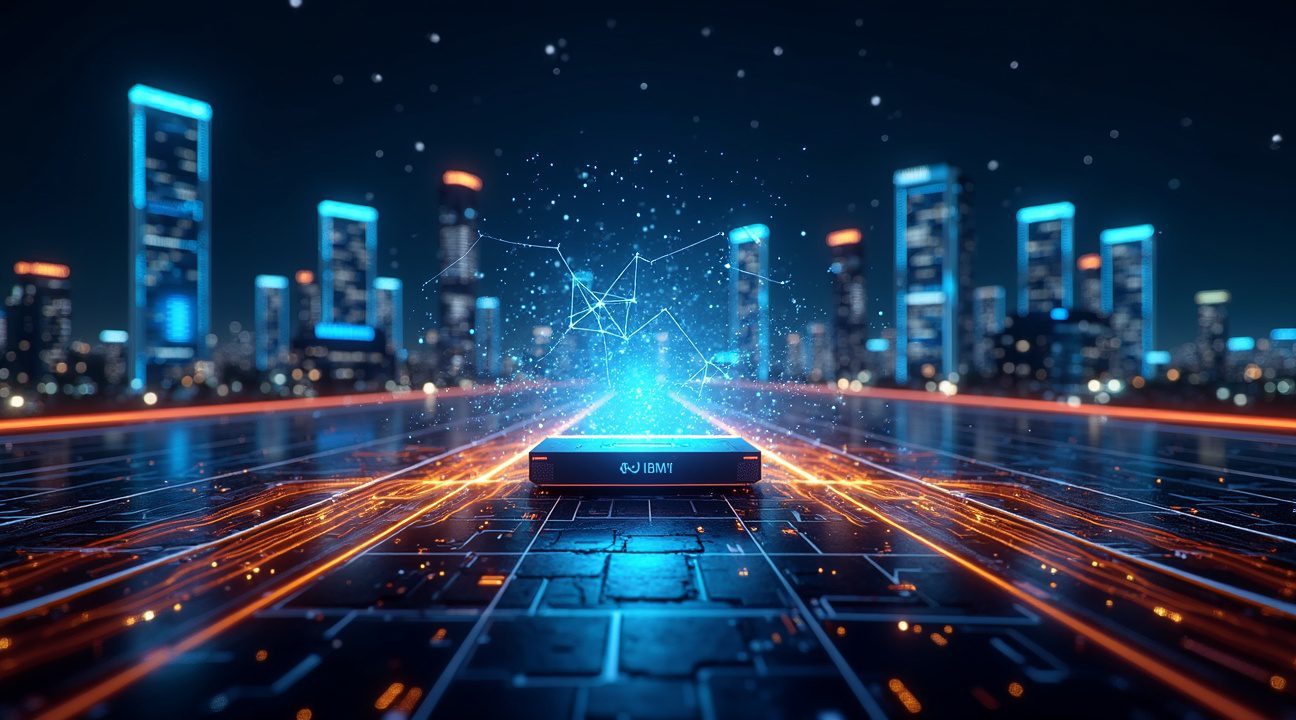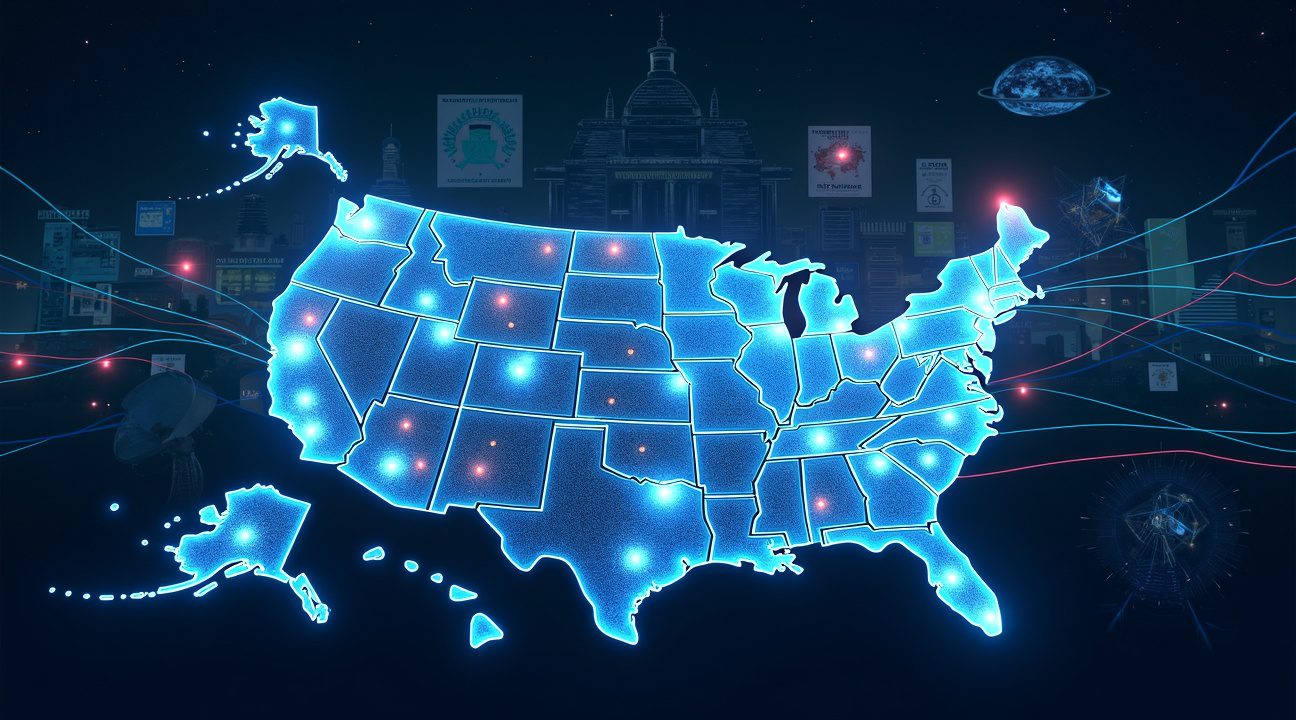The United States has reached a historic achievement in cybersecurity by creating the world’s first quantum internet. This revolutionary communication network harnesses quantum mechanics to produce theoretically unbreakable encryption. The quantum network represents a fundamental shift from traditional cybersecurity methods, employing the laws of physics rather than mathematical complexity to protect sensitive information from potential threats.
Key Takeaways
- The quantum internet uses quantum phenomena like entanglement and superposition to create “theory-level unbreakable” security that automatically detects any interception attempts through changes in quantum states.
- The US government has invested $2.5 billion through the National Quantum Initiative (2019–2024) to establish quantum research infrastructure, including 17 national laboratories working on secure quantum network development.
- Current encryption standards protecting 40 billion connected devices face obsolescence by 2035 when quantum computers become powerful enough to break traditional cryptographic methods like RSA and ECC.
- Major breakthroughs in 2025 include IonQ’s successful frequency conversion technology that enables quantum computers to communicate through existing fiber optic cables, and IBM’s roadmap for 4,158-qubit quantum systems.
- Despite 95% of organizations expressing concern about quantum threats to their data encryption, only 5% have developed concrete strategies to address the coming quantum revolution, creating a dangerous preparedness gap.
Why 40 Billion Connected Devices Face an Existential Threat by 2035
Current digital security stands on borrowed time. Quantum computers are racing toward a moment that will shatter cryptographic standards, and this digital reckoning is expected around 2035. I’ve examined the research, and the numbers paint a sobering picture of what’s coming for our connected world.
The Quantum Cryptographic Collapse
Shor’s algorithm represents the mathematical weapon that will render today’s encryption obsolete. This quantum algorithm can factor large numbers exponentially faster than classical computers, making RSA and ECC encryption vulnerable to attack. By 2030, approximately 40 billion connected devices will populate the global network. E-commerce alone is projected to account for around 4% of global GDP by 2029, creating an enormous target for malicious actors.
The timeline feels distant until you consider the implications. By 2040, organized criminal groups could leverage quantum computing power to execute devastating attacks on financial systems, steal identities on an unprecedented scale, and compromise sensitive healthcare records. Artificial intelligence technologies will likely amplify these threats as they integrate with quantum capabilities.
Industry Fears Becoming Reality
Security professionals aren’t ignoring these warning signs. Survey data reveals that 62% of technology and cybersecurity experts fear quantum computing could break current internet encryption standards. Even more concerning, 73% of surveyed businesses in the US believe it’s inevitable that cybercriminals will use quantum technology to decrypt existing protocols.
Experts warn that quantum cryptanalysis could “literally break the internet.” Compromised cryptographic protocols would create cascading failures across critical infrastructure:
- Energy grids
- Water systems
- Transportation networks
- Financial platforms
All of these depend on encryption that quantum computers could easily defeat. Military systems face particular vulnerability, as quantum-enabled adversaries could decrypt battlefield communications, expose defense strategies, and fundamentally undermine national security.
The threat extends beyond isolated attacks. Connected medical devices, smart city infrastructure, and space exploration technologies all rely on cryptographic protection that will become worthless against quantum adversaries. Financial institutions processing trillions in daily transactions would face constant exposure to sophisticated quantum-powered theft.
The quantum threat isn’t science fiction anymore. It’s a mathematical certainty approaching with every advancement in quantum computing power. Organizations that wait until 2035 to address these vulnerabilities will find themselves defending against an enemy that has already won.

September 2025: The Quantum Frequency Conversion Breakthrough That Changes Everything
IonQ’s September 2025 achievement represents a pivotal moment in quantum communications history. The company successfully demonstrated frequency conversion of photons from visible wavelengths—those used to interface with trapped barium ions—into telecom wavelengths on a prototype system. This breakthrough solves one of the most pressing challenges in quantum networking: how to connect quantum computers across vast distances using existing fiber optic infrastructure.
The frequency conversion technology acts as a translator between quantum computers and traditional communication networks. Without this capability, quantum systems would remain isolated islands, unable to form the interconnected web necessary for a truly global quantum internet. IonQ’s success means quantum information can now travel through standard fiber optic cables that already connect cities, countries, and continents.
Building the Quantum Computing Powerhouse Network
Following IonQ’s breakthrough, major tech giants began announcing ambitious expansion plans. IBM and Cisco revealed their November 2025 strategy to build a network of large-scale, fault-tolerant quantum computers. This partnership combines IBM’s quantum computing expertise with Cisco’s networking infrastructure knowledge, creating a foundation for distributed quantum processing.
The hardware race has accelerated dramatically:
- Fujitsu and RIKEN announced their 256-qubit superconducting quantum computer in April 2025—a system four times larger than their 2023 predecessor. Their roadmap targets a 1,000-qubit machine by 2026.
- IBM‘s roadmap calls for the Kookaburra processor in 2025, featuring 1,386 qubits in a multi-chip configuration. The system includes quantum communication links connecting three chips into a 4,158-qubit system.
- IonQ has set the most ambitious target, planning to deliver quantum computers with 2 million qubits by 2030. This represents a quantum leap in processing power that could revolutionize everything from artificial intelligence development to cryptographic security.
The most significant development throughout 2025 has been dramatic progress in quantum error correction. Previously considered the fundamental barrier to scalable quantum computing, error correction advances now enable reliable quantum operations at unprecedented scales.
These improvements directly support the feasibility of an unhackable quantum internet, where information can be transmitted with absolute security through quantum entanglement principles. Unlike traditional cybersecurity methods, quantum encryption becomes unbreakable due to the laws of physics rather than mathematical complexity.

$2.5 Billion Investment Powers America’s Quantum Internet Race
The White House has launched a comprehensive quantum policy acceleration initiative that positions America at the forefront of the quantum revolution. I’ve observed how this strategic approach includes preparing executive actions specifically focused on federal adoption of quantum technology and managing the complex transition to post-quantum cryptography. These policy moves demonstrate the administration’s recognition that quantum supremacy will determine future national security capabilities.
Federal investment has reached unprecedented levels through the U.S. National Quantum Initiative, which allocated $2.5 billion across programs spanning 2019 to 2024. This substantial funding established the Quantum Leap Challenge Institutes and created the National Quantum Virtual Laboratory as critical national resources for quantum research and development. Such massive financial commitment reflects America’s determination to maintain technological leadership in an increasingly competitive global landscape.
Department of Energy’s Blueprint for Quantum Security
The Department of Energy has unveiled an ambitious blueprint for a revolutionary quantum Internet that promises much stronger security, higher speeds, and enhanced capabilities far beyond current network infrastructure. All 17 national laboratories under the department’s umbrella are actively contributing to this secure network development, creating applications that span science, industry, and national security sectors.
DARPA’s Quantum Computing Initiative
DARPA has launched the Underexplored Systems for Utility Scale Quantum Computing (US2QC) program, investigating whether any quantum computing approach can achieve utility-scale operation where computational value exceeds operational costs by 2033. This timeline establishes a clear benchmark for when quantum systems must demonstrate practical advantages over traditional computing methods.
The program explores several key areas that will determine quantum computing’s commercial viability:
- Assessment of quantum hardware scalability across different technological approaches
- Evaluation of quantum algorithm efficiency for real-world problem solving
- Analysis of error correction methods that maintain quantum coherence at scale
- Investigation of quantum networking protocols for distributed computing systems
Transitioning to post-quantum cryptography presents significant challenges that industry experts acknowledge will require a decade or more to fully implement. Legacy infrastructure complexity creates bottlenecks that can’t be easily upgraded, particularly in government and enterprise networks that rely on deeply embedded cryptographic systems.
The timing coincides perfectly with 2025 being designated as the International Year of Quantum Science and Technology by the United Nations. This global recognition amplifies America’s quantum initiatives and provides additional momentum for international collaboration on quantum standards and protocols.
Current estimates suggest that government and enterprise networks face particularly complex transitions to post-quantum cryptography due to the intricate nature of existing security frameworks. Organizations must carefully plan phased implementations that maintain security while gradually incorporating quantum-resistant algorithms.
The convergence of substantial federal investment, coordinated research efforts, and strategic policy initiatives creates an environment where America’s quantum internet development accelerates beyond theoretical concepts into practical deployment. These efforts represent more than technological advancement—they establish the foundation for maintaining national security advantages in an era where cybersecurity threats continue evolving.
Federal agencies recognize that quantum networking capabilities will fundamentally transform how sensitive information travels across networks. The unhackable properties inherent in quantum communication protocols offer unprecedented protection against foreign interference and cyber attacks.
Research institutions across America are collaborating through the National Quantum Virtual Laboratory framework, sharing resources and expertise that accelerate breakthrough discoveries. This collaborative approach ensures that quantum internet development benefits from diverse perspectives and specialized knowledge across multiple scientific disciplines.
The strategic investment approach demonstrates how government funding can catalyze private sector innovation while maintaining national security priorities. Industry partnerships formed through these initiatives create pathways for quantum technologies to transition from laboratory environments into commercial applications that benefit both military and civilian sectors.

How the Quantum Internet’s ‘Unbreakable’ Security Actually Works
I find the quantum internet’s security architecture fascinating because it operates on fundamentally different principles than traditional networks. While conventional cybersecurity relies on mathematical complexity that could theoretically be broken with enough computing power, quantum security draws its strength directly from the laws of physics themselves.
The quantum internet harnesses several key quantum phenomena to create its protective framework. Quantum superposition allows particles to exist in multiple states simultaneously until measured, while quantum entanglement creates instantaneous connections between particles regardless of distance. These properties enable advanced quantum coding methods that fundamentally change how information travels and remains secure.
Quantum Key Distribution and Enhanced Randomization
The system’s most critical security features include several interconnected technologies that work together to ensure complete protection:
- Quantum Key Distribution (QKD) enables two parties to share encryption keys that remain completely private, with any attempt at interception immediately detected through quantum state changes.
- Quantum Random Number Generators (QRNGs) create truly random encryption keys by leveraging quantum uncertainty, eliminating the predictability issues that plague traditional random number generation.
- Quantum teleportation protocols allow secure transmission of quantum states across the network without physical particle movement.
- Advanced entangled network structures create communication channels that automatically detect any unauthorized access attempts.
What makes this system theoretically unbreakable isn’t computational difficulty—it’s the fundamental behavior of quantum particles themselves. When someone tries to intercept quantum-encrypted data, the very act of observation changes the quantum states involved. This creates an immediate alert that the communication has been compromised, something impossible with traditional encryption methods.
Quantum cryptography provides what researchers call “theory-level unbreakable” security because breaking it would require violating the established laws of quantum mechanics. Traditional encryption might be cracked by future technological advances, but quantum encryption’s security is guaranteed by physics itself.
The quantum internet’s architecture controls and transmits information through quantum states rather than classical bits. Each quantum bit, or qubit, can exist in superposition until measured, creating exponentially more complex encryption possibilities. The entangled network structure ensures that any tampering attempt immediately disrupts the quantum correlations, making unauthorized access mathematically impossible rather than just computationally difficult.
This represents a paradigm shift from reactive cybersecurity—detecting breaches after they occur—to preventive security that makes breaches physically impossible. The quantum internet doesn’t just protect data better; it redefines what data protection means entirely.
Why 95% of Organizations Are Dangerously Unprepared for the Quantum Revolution
The statistics paint a sobering picture of corporate readiness for quantum threats. Most businesses surveyed express being extremely concerned about quantum computing’s potential to break through their data encryption, yet their actions tell a different story. While 62% of technology and cybersecurity professionals fear quantum computing could break current internet encryption standards, only 5% consider it a high priority in the near term, and only 5% report their organizations have a defined strategy to address quantum threats.
This disconnect between concern and action creates a dangerous vulnerability gap. In Canada, 62% of technology and cybersecurity professionals admit they need to do a better job of evaluating their current capabilities to ensure their data remains secure. The figure jumps to 81% in the US, highlighting a continental crisis in quantum preparedness.
Current Encryption Standards Face Imminent Obsolescence
Organizations clinging to traditional encryption methods are essentially building castles on quicksand. The cost of cybercrime is projected to reach $10.5 trillion USD by the end of 2025, and quantum computing threatens to accelerate this trajectory exponentially. Companies haven’t grasped that their current security infrastructure will crumble against quantum attacks.
NIST released a status report in March 2025 on the fourth round of its post-quantum cryptography standardization process, establishing cryptographic standards that can withstand threats posed by quantum computers. The agency detailed a new algorithm for post-quantum encryption called HQC, which will serve as a backup for ML-KEM (Module-Lattice-Based Key-Encapsulation Mechanism), the main algorithm for general encryption.
However, even these quantum-resistant solutions aren’t foolproof. The discovery of vulnerabilities in the NIST-selected encryption algorithm CRYSTALS-Kyber demonstrates how quickly supposedly secure systems can become compromised. Today’s quantum solutions are creating a false sense of security—no one knows if quantum algorithms considered resistant will remain that way as quantum computers become larger and more mainstream.
Artificial intelligence developments parallel the quantum revolution, yet most organizations remain reactive rather than proactive. The gap between awareness and implementation continues to widen, leaving companies vulnerable to unprecedented cyber threats. Technology advances in quantum computing accelerate daily, but corporate security strategies lag years behind these developments.
The 2025–2045 Roadmap: When Quantum Computing Goes From Lab to Reality
Quantum computing stands at the threshold of transforming from laboratory curiosity to commercial reality. I expect meaningful applications to emerge within the next five to ten years, particularly for specific problem classes where quantum systems can demonstrate clear advantages over classical computers.
Near-Term Breakthroughs in Critical Domains
Materials science problems involving strongly interacting electrons and lattice models appear closest to achieving quantum advantage. These applications align perfectly with Department of Energy scientific workloads, including materials science, quantum chemistry, and high-energy physics, which could benefit from quantum systems within the next decade.
The primary application domains driving early adoption include:
- Drug discovery processes that require molecular simulation capabilities
- Materials science research for developing next-generation semiconductors and superconductors
- Complex optimization problems in logistics and supply chain management
- Advanced cryptographic applications that leverage quantum properties
Additional sectors poised for quantum integration span financial modeling, where quantum algorithms could revolutionize risk assessment, and artificial intelligence applications that demand massive computational power. Defense and cybersecurity applications represent particularly critical areas where quantum advantages could reshape entire industries.
The Critical 2035 Inflection Point
The realistic deployment timeline stretches from 2025 through 2045, but I identify a pivotal moment around 2035. During this period, quantum computers are expected to become sufficiently powerful to compromise current cryptographic standards that protect everything from banking transactions to government communications.
This timeline creates unprecedented urgency for organizations to transition to post-quantum cryptography before quantum computers achieve code-breaking capabilities. The window for preparation narrows each year as technology advances accelerate quantum development globally.
Government support for quantum technologies has reached extraordinary levels across multiple nations. The U.S. National Quantum Initiative, the EU’s Quantum Flagship, and China’s multi-billion-dollar quantum programs demonstrate that major global powers recognize quantum computing as essential to national security and economic competitiveness. Space exploration agencies are also exploring quantum applications for navigation and communication systems.
A nation achieving quantum superiority could bypass traditional cybersecurity defenses, escalate cyber conflicts, and gain overwhelming strategic advantages in intelligence gathering and economic espionage. This reality makes quantum internet development not just a technological achievement but a national security imperative that could determine global power balances for decades to come.

Sources:
Spinquanta – “Quantum Computing Industry Trends 2025”
SSH Communications Security – “Quantum Computing Threats”
Communications of the ACM – “Advances in the Quantum Internet”
IonQ – “IonQ Achieves Significant Quantum Internet Milestone”
Boston Consulting Group – “How Quantum Computing Will Upend Cybersecurity”
International Advanced Research Journal in Science, Engineering and Technology – “Quantum Computing”
IBM Newsroom – “IBM and Cisco Announce Plans to Build a Network of Large-Scale, Fault-Tolerant Quantum Computers”
KPMG – “Quantum Computing Cybersecurity Threats”
Peak and Valley – “Quantum Internet Explained”
McKinsey & Company – “The Year of Quantum: From Concept to Reality in 2025”
ISACA – “ISACA Warns That Quantum Computing Poses Major Cybersecurity Risk”
Government Technology – “Is a New Quantum Internet Coming? The Latest DOE Efforts”
Cloudflare – “State of Post-Quantum Internet 2025”
Cybersecurity Ventures – “The Growing Impact of AI and Quantum on Cybersecurity”
Microsoft Azure Blog – “2025: The Year to Become Quantum Ready”
Mixmind7090 on Medium – “Quantum Internet Explained: Why It Can’t Be Hacked”
Live Science – “Quantum Computing Will Make Cryptography Obsolete”
University of Chicago News – “Quantum Internet Explained”


